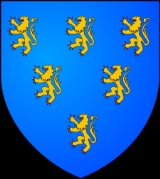
Armorial of Plantagenet
Encyclopedia
This is a list of the coats of arms
known or believed to be borne by Geoffrey Plantagenet, Count of Anjou, and his descendants in the male line.
House of Lancaster
House of York
Coat of arms
A coat of arms is a unique heraldic design on a shield or escutcheon or on a surcoat or tabard used to cover and protect armour and to identify the wearer. Thus the term is often stated as "coat-armour", because it was anciently displayed on the front of a coat of cloth...
known or believed to be borne by Geoffrey Plantagenet, Count of Anjou, and his descendants in the male line.
Family chief
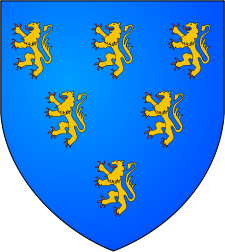 |
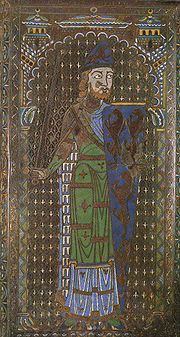 Geoffrey V, Count of Anjou Geoffrey V , called the Handsome and Plantagenet, was the Count of Anjou, Touraine, and Maine by inheritance from 1129 and then Duke of Normandy by conquest from 1144... (1113 † 1151), Count of Anjou Azure, six lions rampant or That Geoffrey used this coat is inferred from his memorial enamel, which shows four lions on half of his shield, arranged in a manner to suggest that this was the same as the six-lion shield borne by his grandson William Longespée, 3rd Earl of Salisbury (c. 1176 † 1226; illegitimate son of Geoffrey's son Henry II of England) and by William's son William II Longespée William II Longespee Sir William II Longespée, long sword in French, was the son of William Longespée, 3rd Earl of Salisbury, and Ela, 3rd Countess of Salisbury... (c. 1212 † 1250). |
 |
Henry II Henry II of England Henry II ruled as King of England , Count of Anjou, Count of Maine, Duke of Normandy, Duke of Aquitaine, Duke of Gascony, Count of Nantes, Lord of Ireland and, at various times, controlled parts of Wales, Scotland and western France. Henry, the great-grandson of William the Conqueror, was the... (1133 † 1189), son of previous, king of England, duke of Normandy, count of Anjou. No coat is directly attested for him, but it has been deduced from the bearings of his immediate family that he bore a coat with two lions passant, with the tinctures unknown.
By later tradition, Henry II is said to have used the arms that later came to designate the Duchy of Normandy Duchy of Normandy The Duchy of Normandy stems from various Danish, Norwegian, Hiberno-Norse, Orkney Viking and Anglo-Danish invasions of France in the 9th century... : gules, two lions passant guardant in pale or This coat was used by:
In French blazoning, the lion passant guardant was often termed a léopard. However, this usage was never widespread in England, and is long obsolete. |
 or perhaps  or  |
  Richard I of England Richard I was King of England from 6 July 1189 until his death. He also ruled as Duke of Normandy, Duke of Aquitaine, Duke of Gascony, Lord of Cyprus, Count of Anjou, Count of Maine, Count of Nantes, and Overlord of Brittany at various times during the same period... (1157 † 1199), son of previous, king of England, duke of Normandy and Aquitaine, count of Anjou and Poitiers His arms are only known from two armorial seals, and hence the tinctures can not be determined. His First Great Seal showed one lion on half of the shield. It is debated whether this was meant to represent two lions combattant or a single lion, and if the latter, whether the direction in which the lion is facing is relevant or simply an artistic liberty. A simple lion rampant is most likely. At the end of his life, his second seal showed three lions, clearly the three-lion coat used by his successors. http://perso.numericable.fr/~earlyblazo/specialarms/richard.htm |
Kings of England and dukes of Aquitaine from 1198 to 1340 :
gules, three lions passant guardant in pale or. |
|
Kings of England and dukes of Aquitaine from 1340 to 1400 :
In 1340, Edward III claimed the throne of France as an inheritance from his mother, Isabella, da. of King Philip IV of France, and adopted new arms, Quarterly France and England. Such arms are termed "Arms of Pretension", where a sovereign adopts arms illustrative of a claim de jure (by right) to the throne of another kingdom. |
|
Kings of England from 1400 to 1603 :
In 1376, the kings of France altered the royal coat of arms, replacing the field semé-de-lis with three fleurs-de-lis, alluding to the Trinity Trinity The Christian doctrine of the Trinity defines God as three divine persons : the Father, the Son , and the Holy Spirit. The three persons are distinct yet coexist in unity, and are co-equal, co-eternal and consubstantial . Put another way, the three persons of the Trinity are of one being... . This new design is referred to as France Moderne, the previous one being France Ancien. From about 1400 the kings of England imitated this change. As modified, the monarchs of England continued to bear arms in this form until the crown union with Scotland in 1603. |
Heirs
 |
Edward of Caernarvon Edward II of England Edward II , called Edward of Caernarfon, was King of England from 1307 until he was deposed by his wife Isabella in January 1327. He was the sixth Plantagenet king, in a line that began with the reign of Henry II... (1284 † 1327), Prince of Wales Prince of Wales Prince of Wales is a title traditionally granted to the heir apparent to the reigning monarch of the United Kingdom of Great Britain and Northern Ireland and the 15 other independent Commonwealth realms... , later King Edward II England with a label of three points azure. This blazon was probably borne by his son Edward Edward III of England Edward III was King of England from 1327 until his death and is noted for his military success. Restoring royal authority after the disastrous reign of his father, Edward II, Edward III went on to transform the Kingdom of England into one of the most formidable military powers in Europe... (later King Edward III) as Prince of Wales. |
 |
Edward of Woodstock Edward, the Black Prince Edward of Woodstock, Prince of Wales, Duke of Cornwall, Prince of Aquitaine, KG was the eldest son of King Edward III of England and his wife Philippa of Hainault as well as father to King Richard II of England.... (1330 † 1376), the Black Prince, Prince of Wales, son of Edward III Quarterly France and England, over all a label of three points argent.. |
 |
Richard of Bordeaux Richard II of England Richard II was King of England, a member of the House of Plantagenet and the last of its main-line kings. He ruled from 1377 until he was deposed in 1399. Richard was a son of Edward, the Black Prince, and was born during the reign of his grandfather, Edward III... (1367 † 1399), son of the Black Prince, later Prince of Wales and later King of England (Richard II). During his father's lifetime he added a cross of Saint George to the middle point of the label. As king, he combined the royal arms with the mythical coat attributed to Edward the Confessor Edward the Confessor Edward the Confessor also known as St. Edward the Confessor , son of Æthelred the Unready and Emma of Normandy, was one of the last Anglo-Saxon kings of England and is usually regarded as the last king of the House of Wessex, ruling from 1042 to 1066.... : Per pale, 1st azure a cross flory between five martlet Martlet A martlet is a heraldic charge depicting a stylized bird with short tufts of feathers in the place of legs... s, all or; 2nd quarterly France and England. |
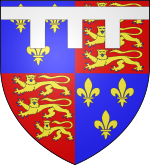 |
Princes of Wales Prince of Wales Prince of Wales is a title traditionally granted to the heir apparent to the reigning monarch of the United Kingdom of Great Britain and Northern Ireland and the 15 other independent Commonwealth realms... from 1405 to 1547 :
Quarterly France and England, over all a label argent. |
cadets
 |
William FitzEmpress (1136 † 1163/4), viscount of Dieppe, then Count of Poitou, son of Geoffrey V Geoffrey V, Count of Anjou Geoffrey V , called the Handsome and Plantagenet, was the Count of Anjou, Touraine, and Maine by inheritance from 1129 and then Duke of Normandy by conquest from 1144... , Count of Anjou, used an arms with a single lion, tinctures unknown. William Longespée (c.1176 † 1226), earl of Salisbury, illegitimate son of Henry II, king of England first used a single lion, tincture unknown, before adopting the six-lion coat of his paternal grandfather, Geoffrey V Geoffrey V, Count of Anjou Geoffrey V , called the Handsome and Plantagenet, was the Count of Anjou, Touraine, and Maine by inheritance from 1129 and then Duke of Normandy by conquest from 1144... , Count of Anjou. |
  |
Richard Richard, 1st Earl of Cornwall Richard of Cornwall was Count of Poitou , 1st Earl of Cornwall and German King... (1209 † 1272), earl of Cornwall, then king of the Romans, son of John Lackland, king of England Argent, a lion rampant gules crowned or a bordure sable bezantée. Arms of the counts of Poitiers (see Richard Lionheart above), with a brisure Cadency In heraldry, cadency is any systematic way of distinguishing similar coats of arms belonging to members of the same family. Cadency is necessary in heraldic systems in which a given design may be owned by only one person at once... . |
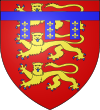 |
Earls of Lancaster Earl of Lancaster The title of Earl of Lancaster was created in the Peerage of England in 1267, merging in the crown in 1399. See also Duke of Lancaster.-Earls of Lancaster :... issued from Edmund Crouchback Edmund Crouchback, 1st Earl of Lancaster Edmund of Crouchback, 1st Earl of Leicester and Lancaster , was the second surviving son of King Henry III of England and Eleanor of Provence. In his childhood he had a claim on the Kingdom of Sicily. His nickname refers to his participation in the Ninth Crusade.-Childhood:Edmund was born in London... England with a label azure semé-de-lis or..
|
 |
Henry Henry, 3rd Earl of Lancaster Henry , 3rd Earl of Leicester and Lancaster was an English nobleman, one of the principals behind the deposition of Edward II of England.-Family and lineage:... (1281 † 1345), earl of Leicester, son of Edmund Crouchback, 1st Earl of Lancaster, before restoration as Earl of Lancaster in 1327 England with a bendlet azure. |
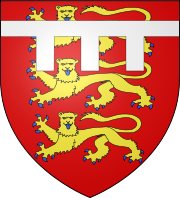 |
Thomas of Brotherton Thomas of Brotherton, 1st Earl of Norfolk Thomas of Brotherton, 1st Earl of Norfolk, Lord Marshal of England was the son of Edward I of England and Margaret of France.-Early life:... (1300 † 1338), Earl of Norfolk, son of Edward I Longshanks. England with a label of three points argent. |
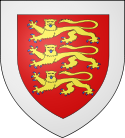 |
Edmund of Woodstock Edmund of Woodstock, 1st Earl of Kent Edmund of Woodstock, 1st Earl of Kent was a member of the English Royal Family.-Early life:He was born at Woodstock in Oxfordshire, the son of Edward I Longshanks, King of England and his second wife, Margaret of France. He was 62 years younger than his father, who died when Edmund of Woodstock... (1301 † 1330), Earl of Kent, son of Edward I. England with a bordure argent. His daughter Joan of Kent Joan of Kent Joan, Countess of Kent , known to history as The Fair Maid of Kent, was the first English Princess of Wales... and her descendants the Holland earls of Kent bore these arms. |
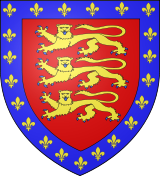 |
John of Eltham John of Eltham, Earl of Cornwall John of Eltham, 1st Earl of Cornwall was the second son of Edward II of England and Isabella of France. He was heir to the English throne from the date of the abdication of his father to the birth of his nephew Edward of Woodstock .-Life:John was born in 1316 at Eltham Palace, Kent... (1316 † 1336), Earl of Cornwall, son of Edward II England with a bordure azure charged with fleurs-de-lis or. |
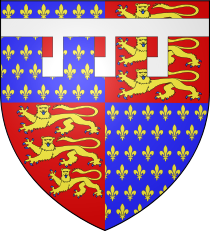 |
Lionel of Antwerp Lionel of Antwerp, 1st Duke of Clarence Lionel of Antwerp, 1st Duke of Clarence, jure uxoris 4th Earl of Ulster and 5th Baron of Connaught, KG was the third son, but the second son to survive infancy, of Edward III of England and Philippa of Hainault... (1338 † 1368), 1st Duke of Clarence, second son of Edward III. Quarterly France and England, over all a label of five points, each point bearing a cross gules. There is also evidence that he sometimes carried, as pictured, Quarterly France and England, over all a label of three points, each point bearing a canton gules. |
 |
Thomas of Woodstock Thomas of Woodstock, 1st Duke of Gloucester Thomas of Woodstock, 1st Duke of Gloucester, 1st Earl of Buckingham, 1st Earl of Essex, Duke of Aumale, KG was the thirteenth and youngest child of King Edward III of England and Philippa of Hainault... (1355 † 1397), earl of Essex, of Buckingham and duke of Gloucester, fifth son of Edward III Quarterly France and England, over all a bordure argent. |
House of LancasterHouse of LancasterThe House of Lancaster was a branch of the royal House of Plantagenet. It was one of the opposing factions involved in the Wars of the Roses, an intermittent civil war which affected England and Wales during the 15th century...
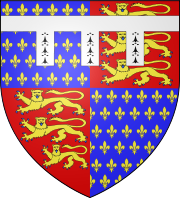 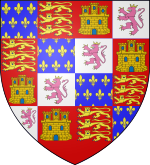 |
John of Gaunt John of Gaunt, 1st Duke of Lancaster John of Gaunt, 1st Duke of Lancaster , KG was a member of the House of Plantagenet, the third surviving son of King Edward III of England and Philippa of Hainault... (1340 † 1399), Duke of Lancaster, third son of Edward III. In 1371, he married Constance of Castile Constance of Castile (1354-1394) Constance of Castile was claimant of the Castilian throne after the death of her father Peter the Cruel, her mother being María de Padilla, whom Peter had secretly married but was then forced to repudiate, only to keep her as a mistress... , heiress of Pedro the Cruel Pedro of Castile Peter , sometimes called "the Cruel" or "the Lawful" , was the king of Castile and León from 1350 to 1369. He was the son of Alfonso XI of Castile and Maria of Portugal, daughter of Afonso IV of Portugal... , king of Castile and Leon. Claiming the throne of Castile and Leon, he quartered the arms of France-England with those of Castile-Leon. Quarterly, 1st and 4th quarterly France and England, 2nd and 3rd quarterly Castile and Leon. |
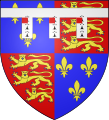 |
Thomas of Lancaster Thomas of Lancaster, 1st Duke of Clarence Thomas of Lancaster, 1st Duke of Clarence, KG , also known as Thomas Plantagenet, was the second son of King Henry IV of England and his first wife, Mary de Bohun. He was born before 25 November 1387 as on that date his father's accounts note a payment made to a woman described as his nurse... (1388 † 1421), Duke of Clarence, son of Henry IV. Quarterly France and England, over all a label of three points ermine, on each point a canton gules. |
 |
John of Lancaster John of Lancaster, 1st Duke of Bedford John of Lancaster, 1st Duke of Bedford, KG , also known as John Plantagenet, was the third surviving son of King Henry IV of England by Mary de Bohun, and acted as Regent of France for his nephew, King Henry VI.... (1389 † 1435), Duke of Bedford, son of Henry IV. |
 |
Humphrey of Lancaster Humphrey, Duke of Gloucester Humphrey of Lancaster, 1st Duke of Gloucester, 1st Earl of Pembroke, KG , also known as Humphrey Plantagenet, was "son, brother and uncle of kings", being the fourth and youngest son of king Henry IV of England by his first wife, Mary de Bohun, brother to king Henry V of England, and uncle to the... (1389 † 1447), Duke of Gloucester, son of Henry IV. Quarterly France and England, over all a bordure argent. |
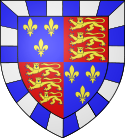 |
Earls and dukes of Somerset Duke of Somerset Duke of Somerset is a title in the peerage of England that has been created several times. Derived from Somerset, it is particularly associated with two families; the Beauforts who held the title from the creation of 1448 and the Seymours, from the creation of 1547 and in whose name the title is... issued from John Beaufort John Beaufort, 1st Earl of Somerset John Beaufort, 1st Marquess of Somerset and 1st Marquess of Dorset, later only 1st Earl of Somerset, KG was the first of the four illegitimate children of John of Gaunt, 1st Duke of Lancaster, and his mistress Katherine Swynford, later his wife... (1371 † 1410), son of John of Gaunt:
Quarterly France and England, over all a bordure compony argent and azure. |
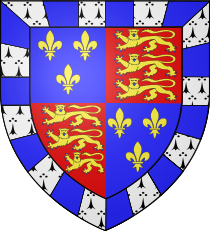 |
Thomas Beaufort Thomas Beaufort, Duke of Exeter Thomas Beaufort, 1st Duke of Exeter, KG was an English military commander during the Hundred Years' War, and briefly Chancellor of England. He was the third of four children; the son of John of Gaunt, Duke of Lancaster, and his mistress Katherine Swynford... (1377 † 1426), Duke of Exeter, son of John of Gaunt Quarterly France and England, over all a bordure compony ermine and azure. |
House of YorkHouse of YorkThe House of York was a branch of the English royal House of Plantagenet, three members of which became English kings in the late 15th century. The House of York was descended in the paternal line from Edmund of Langley, 1st Duke of York, the fourth surviving son of Edward III, but also represented...
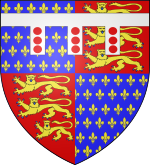 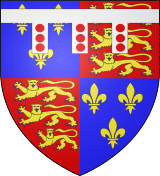 |
Dukes of York Duke of York The Duke of York is a title of nobility in the British peerage. Since the 15th century, it has, when granted, usually been given to the second son of the British monarch. The title has been created a remarkable eleven times, eight as "Duke of York" and three as the double-barreled "Duke of York and... issued from Edmund of Langley Edmund of Langley, 1st Duke of York Edmund of Langley, 1st Duke of York, 1st Earl of Cambridge, KG was a younger son of King Edward III of England and Philippa of Hainault, the fourth of the five sons who lived to adulthood, of this Royal couple. Like so many medieval princes, Edmund gained his identifying nickname from his... , fourth son of Edward III. His son Edward of Norwich Edward of Norwich, 2nd Duke of York Sir Edward of Norwich, 2nd Duke of York, 2nd Earl of Cambridge, Earl of Rutland, Earl of Cork, Duke of Aumale KG was a member of the English royal family who died at the Battle of Agincourt.... followed the king in reducing the fleurs-de-lis to three.
Quarterly France and England, with a label of three points argent, each point charged with three torteaux. |
 |
Richard of Conisburgh Richard of Conisburgh, 3rd Earl of Cambridge Richard of Conisburgh, 3rd Earl of Cambridge was the younger son of Edmund of Langley, 1st Duke of York and Isabella of Castile.... (1376 † 1415), 3rd Earl of Cambridge, son of Edmund of Langley. Quarterly France and England, with a label of three points argent, each point charged with three torteaux, a bordure argent charged with lions rampant gules. |
 |
Richard of Shrewsbury Richard of Shrewsbury, 1st Duke of York Richard of Shrewsbury, 1st Duke of York, 1st Duke of Norfolk, 1st Earl of Norfolk, Earl Marshal was the sixth child and second son of King Edward IV of England and Elizabeth Woodville. He was born in Shrewsbury.... (1473 † 1483), Duke of York, second son of Edward IV. Quarterly France and England, a label of three points argent, on the first point a canton gules. |
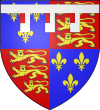 |
George George Plantagenet, 1st Duke of Clarence George Plantagenet, 1st Duke of Clarence, 1st Earl of Salisbury, 1st Earl of Warwick, KG was the third son of Richard Plantagenet, 3rd Duke of York, and Cecily Neville, and the brother of kings Edward IV and Richard III. He played an important role in the dynastic struggle known as the Wars of the... (1449 † 1478), Duke of Clarence, brother of Edward IV. Quarterly France and England, a label of three points argent, on each point a canton gules. |
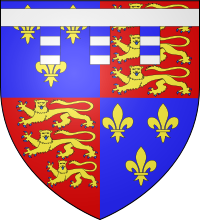 |
Edward Edward Plantagenet, 17th Earl of Warwick Edward Plantagenet, 17th Earl of Warwick was the son of George Plantagenet, 1st Duke of Clarence and a potential claimant to the English throne during the reigns of both Richard III and his successor, Henry VII... (1475 † 1499), Earl of Warwick, son of George, Duke of Clarence. Quarterly France and England, a label of three points barry argent and azure. |
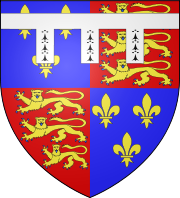 |
Richard Richard III of England Richard III was King of England for two years, from 1483 until his death in 1485 during the Battle of Bosworth Field. He was the last king of the House of York and the last of the Plantagenet dynasty... (1452 † 1485), duke of Gloucester, brother of Edward IV, later Richard III. Quarterly France and England, a label of three points ermine. |

